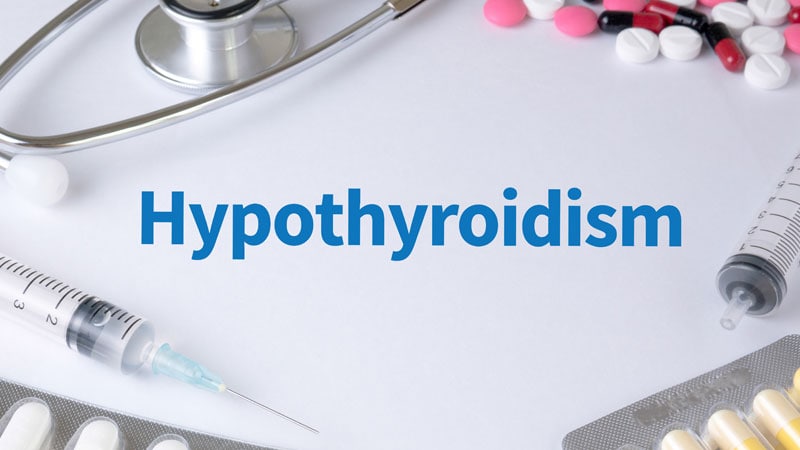Predicting Hypothyroid Onset in Adults With Kidney Disease
Core Concepts
Development of a prediction tool for hypothyroidism in adults with kidney disease.
Abstract
The study focused on developing and validating a prediction tool for estimating the risk of incident hypothyroidism in adults with moderate-to-advanced chronic kidney disease (CKD). The cohort included 15,642 adults with stage 4-5 CKD, with 10.5% developing incident hypothyroidism during a median 3.4 years follow-up. Factors such as race, baseline TSH levels, and certain medical conditions were associated with the risk of hypothyroidism. The prediction model showed good discrimination, with a C-statistic of 0.77-0.76. The tool aims to improve clinical management by identifying patients who require prioritized screening and treatment.
TOPLINE:
Prediction tool for hypothyroidism in CKD adults.
Cohort of 15,642 adults with stage 4-5 CKD.
10.5% developed incident hypothyroidism.
METHODOLOGY:
Derived prediction model from 10,428 patients.
Internal validation on 5,214 patients.
Incident hypothyroid cases based on TSH levels.
TAKEAWAY:
Factors influencing hypothyroidism risk identified.
Higher TSH levels and amiodarone use linked to increased risk.
Model's discrimination indicated at 76%-77%.
IN PRACTICE:
Tool can aid in clinical management of CKD patients.
Potential for automated analysis in EHR.
SOURCE:
Study conducted by researchers from the University of California, Irvine.
LIMITATIONS:
Model caution for milder kidney dysfunction patients.
Data accuracy crucial for model performance.
Limitations in thyroid autoimmunity measurement.
Predicting Hypothyroid Onset in Adults With Kidney Disease
Stats
During median 3.4 years follow-up, 1650 (10.5%) of the patients developed incident hypothyroidism.
The model’s discrimination was good, producing similar C-statistics in both the development dataset 0.77, and validation dataset 0.76.
Quotes
"The findings have the potential to improve the quality of care of CKD patients."
Key Insights Distilled From
by Mitchel L. Z... at www.medscape.com 06-14-2023
https://www.medscape.com/viewarticle/993205
Deeper Inquiries
How can the prediction tool be adapted for patients with milder kidney dysfunction?
The prediction tool developed for estimating the risk of incident hypothyroidism in adults with moderate-to-advanced chronic kidney disease (CKD) can be adapted for patients with milder kidney dysfunction by incorporating additional variables or adjusting the weightage of existing factors in the prediction model. Since the current model was derived and validated using a cohort of patients with stage 4-5 CKD, it may not directly apply to those with milder kidney dysfunction. To adapt the tool, researchers could consider including factors specific to patients with milder CKD, such as different comorbidities, medication use, or laboratory parameters that may influence the risk of hypothyroidism in this population. By recalibrating the model with data from patients with milder kidney dysfunction, healthcare providers can better estimate the risk of hypothyroidism in these individuals and tailor screening and management strategies accordingly.
What are the implications of limited measurement of thyroid autoimmunity in the study cohort?
The limited measurement of thyroid autoimmunity in the study cohort has several implications for the prediction tool and its application in clinical practice. Thyroid autoimmunity, particularly the presence of anti-thyroid peroxidase antibodies, is a known risk factor for hypothyroidism in the general population. However, due to the lack of measurement of these antibodies in the study cohort, the prediction model may not fully capture the autoimmune component of hypothyroidism risk in patients with CKD. This limitation could lead to underestimation of the risk of hypothyroidism in individuals with underlying thyroid autoimmunity, potentially resulting in delayed diagnosis and treatment.
Furthermore, the absence of data on thyroid autoimmunity in the prediction model may limit its accuracy and predictive power, as this important risk factor is not accounted for in the risk assessment. Healthcare providers should be aware of this limitation when using the tool to estimate the risk of hypothyroidism in CKD patients and consider additional testing for thyroid autoantibodies in high-risk individuals to improve the accuracy of risk prediction and enhance patient care.
How might automated analysis in EHR impact healthcare delivery for CKD patients?
Automated analysis in Electronic Health Records (EHR) can have a significant impact on healthcare delivery for CKD patients by streamlining the identification, monitoring, and management of hypothyroidism in this population. By embedding the prediction tool for incident hypothyroidism in the EHR system, healthcare providers can receive real-time risk assessments for individual patients with CKD, enabling proactive screening, timely interventions, and personalized treatment plans.
Automated analysis in EHR can facilitate the identification of high-risk patients who may benefit from prioritized screening for hypothyroidism, serial monitoring of thyroid function tests, and long-term management strategies. This proactive approach to healthcare delivery can lead to early detection of hypothyroidism, prompt initiation of treatment, and improved outcomes for CKD patients.
Furthermore, integrating the prediction tool into the EHR system allows for seamless data analysis, decision support, and care coordination across healthcare settings. Healthcare providers can leverage the predictive model to optimize resource allocation, enhance clinical decision-making, and improve the quality of care for CKD patients with hypothyroidism. Overall, automated analysis in EHR has the potential to revolutionize healthcare delivery for CKD patients by leveraging predictive analytics to improve patient outcomes and enhance the efficiency of clinical practice.
0
